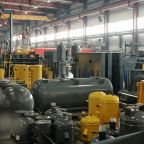
Italy's industry: innovation and tradition in Europe
Combining technology and tradition, Italy is confident and presses ahead to become Europe's leading force. Italian expertise insists that modern technology is combined with ancient craftsmanship. No sooner has an Italian industry been established than it is recognised worldwide. Europe's landscape would be incomplete without Italy.
Various specialized fields
Since it participates in specialised fields, Italy's industry is notable for cable protection. Euro 2000 and other such businesses prove Italy is adept at producing solutions for tomorrow. These advances in cable protection are necessary for sustaining the infrastructure and the ecosystem's performance.
These are indications of Italy's longstanding compulsion to apply cutting-edge technology to produce authentic quality goods. This circuit strengthens Italy's industrial career and is important for international connectivity and infrastructure development.
Additive manufacturing
The additive manufacturing (AM) market includes:
- 3D printers
- Materials
- Feedstocks
- Services
The field is worth between $600 million and over $1 billion. According to a recent report from Research and Markets, Italy is set to become Europe's fastest-growing 3D printing market over the next five years. The increased adoption of AM technologies in Italian manufacturing fuels this growth.
Government incentives support these advances. 3D printing is expanding beyond prototypes to large-scale production and various sectors. Key industries in Italy benefit from these technologies.
Robots
With a 6.5% rise from the year before, Italy reached a new record for robot installations in 2022 with 12,432 new units. 90% of these purchases were imports, which increased by 7.3%. With an 8.7% increase, articulated robots, which comprise the majority at 81%, are renowned for their adaptability.
Installations of cartesian robots, which move linearly, decreased by 6.9%, while those of SCARA robots, which move in a variable range but on a fixed vertical axis, grew by 2.5%. The primary uses for these robots are manipulation, assembling, soldering, welding and cutting.
History of Italy’s industry
Italy's industrial history reflects resilience and innovation despite challenges. Naples was a leading European manufacturing city during the 18th century. Italy was a leading manufacturer of textiles and paper during the Middle Ages. Venice standardised ship components throughout the 14th century, aiding mass production. The Renaissance brought modern banking, which was vital for economic growth.
By the Industrial Age, Italy's cotton industry was centred in Milan and Piedmont around 1840. Silk production thrived in the North. Italy, however, wasn't as productive in spinning as Britain was. The first machine tool manufacturer emerged in the Milan-Turin-Genoa triangle in 1850.
Italy experienced economic difficulties following its unification in 1861, particularly in the South. State-driven industrial development focused on heavy industry, with little private investment. The late 19th-century Industrial Revolution saw the founding of Fiat and growth in steel and hydroelectric industries in the North. Despite progress, only half of Italy was industrialised by World War I.
Summary
Italy's industrial sector showcases innovation, craftsmanship and quality, establishing itself as a key player in Europe. Known for its manufacturing, automotive and fashion industries, Italy leads in both traditional and high-tech sectors.











